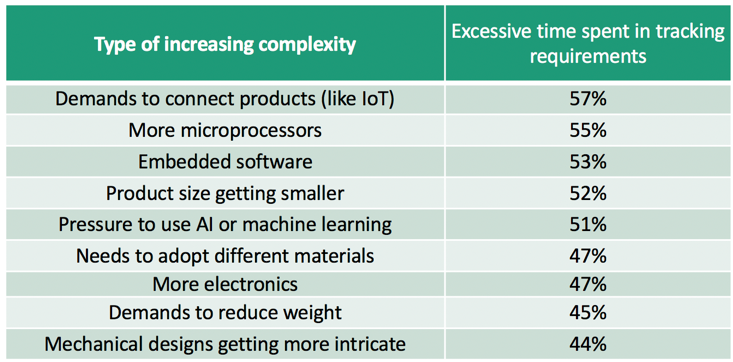
Recently, we explored the results of a Forrester Research report that concluded that highly regulated industries can benefit from an Agile approach to requirements management. In today’s post, we’ll dig deeper into how customers in all industries can benefit from a collaborative platform that helps them manage requirements throughout complex development cycles.
According to a recent report from Engineering.com, in spite of growing product complexity and intense regulations, the majority of design teams don’t have a dedicated requirements management (RM) solution in place. About half use a tool that’s not purpose-built for requirements management, while almost a third have no system in place at all, relying instead on email and shared documents.
Only 15% of teams surveyed by Engineering.com had invested in a dedicated RM solution — but that number should be (and will be) much higher, as more organizations come to understand the long-term value of successful requirements management.
Here are three reasons why your organization needs a RM solution.
Poor requirements management leads to product failures.
Engineering.com reports that more than four out of five design teams have experienced product failure due to substandard requirements management. Failures included exceeding cost requirements and losing time to market, but most teams experienced more than one failed outcome, like a product that was late to market and cost more than expected to build.
The report also showed that organizations using dedicated requirements management platforms in regulated industries not only received fewer instances of warnings, recalls, fines and production stoppages than those that didn’t, but nearly half reported experiencing none of those problems at all.
Teams without the right requirements management tool will ship products that haven’t met requirements.
As product complexity increases, teams without comprehensive RM solutions report shipping products that don’t meet all requirements. There are several reasons why teams report that their products were shipped with missing requirements, many of which can be linked to increased product complexity, including more frequent use of microprocessors, the need to adopt different materials, and demand for embedded software.
Shipping a product that doesn’t meet requirements can lead to reprimands from regulatory agencies or even product recalls, which can permanently damage your brand reputation and position in the market.
Products and systems are only getting more complex, driving the need for the right requirements solution.
More complexity means more time spent tracking requirements. To quote from the Engineering.com report, “Many of the respondents who increased the complexity of their products acknowledged spending excessive time tracking requirements due to poor requirements management. Those needing to connect products (IoT) and add more microprocessors suffered the most, quickly followed by those needing to embed software and reduce product size.”

Image courtesy of Engineering.com
Products are getting smarter, and development teams need intuitive, powerful RM solutions to manage that rising complexity. As the Engineering.com report concludes: “It is clear from the data that the products most design teams are creating are becoming more complex. Yet, they have not thought of investing in the tools available that would help them manage the requirements this complexity demands.”
To dive deeper into the relationship between rising product complexity and effective requirements management, download the full report: “Design Teams: Requirements Management & Product Complexity.”
- 9 Strategies To Overcome Challenges In The EU Medical Device Market In 2025 And Beyond - February 6, 2025
- Leveraging Jama Connect® and Jira for Enhanced Requirements - January 30, 2025
- With Hacks on the Rise, Manufacturers Hone Their Cybersecurity Smarts - January 23, 2025